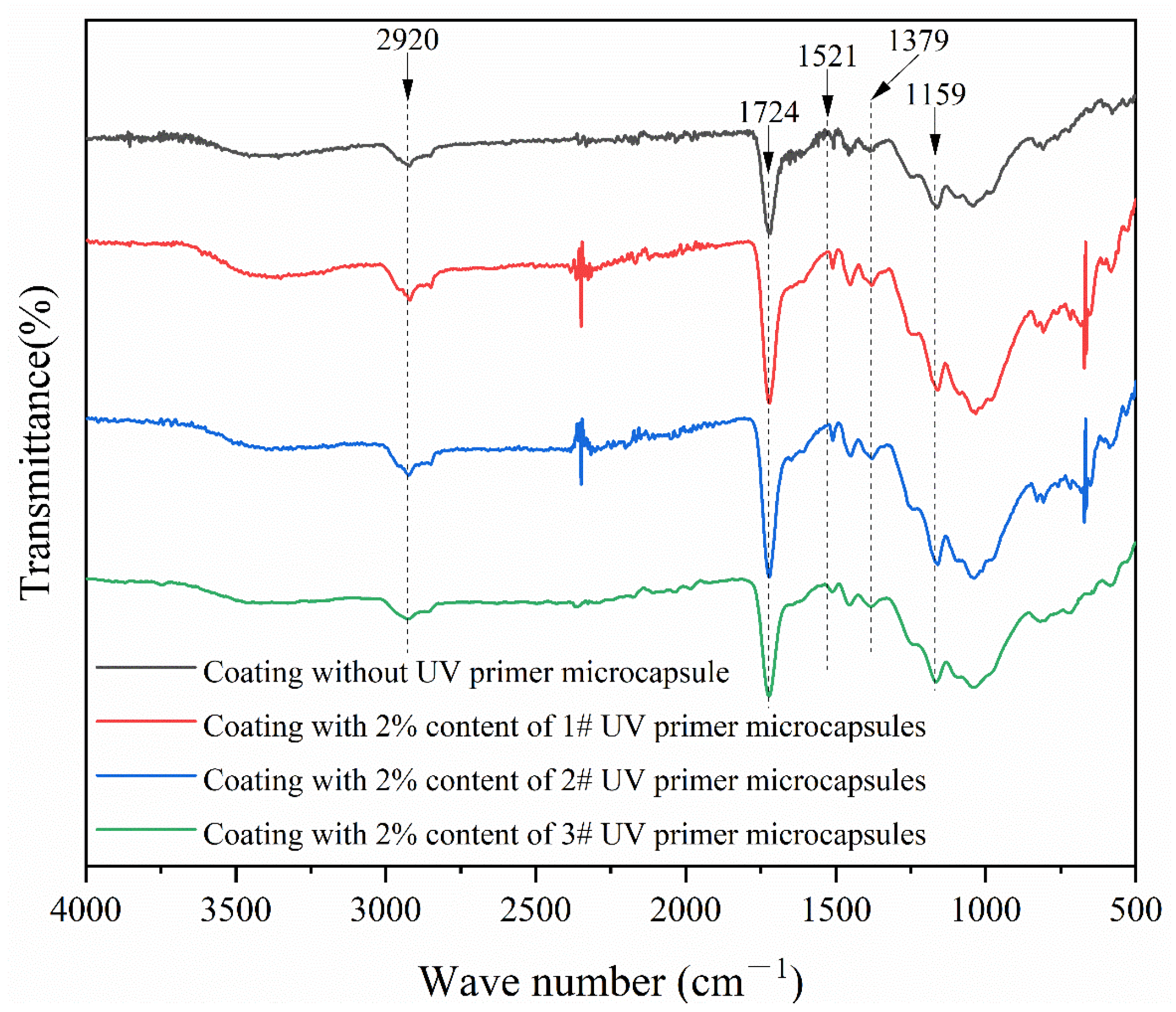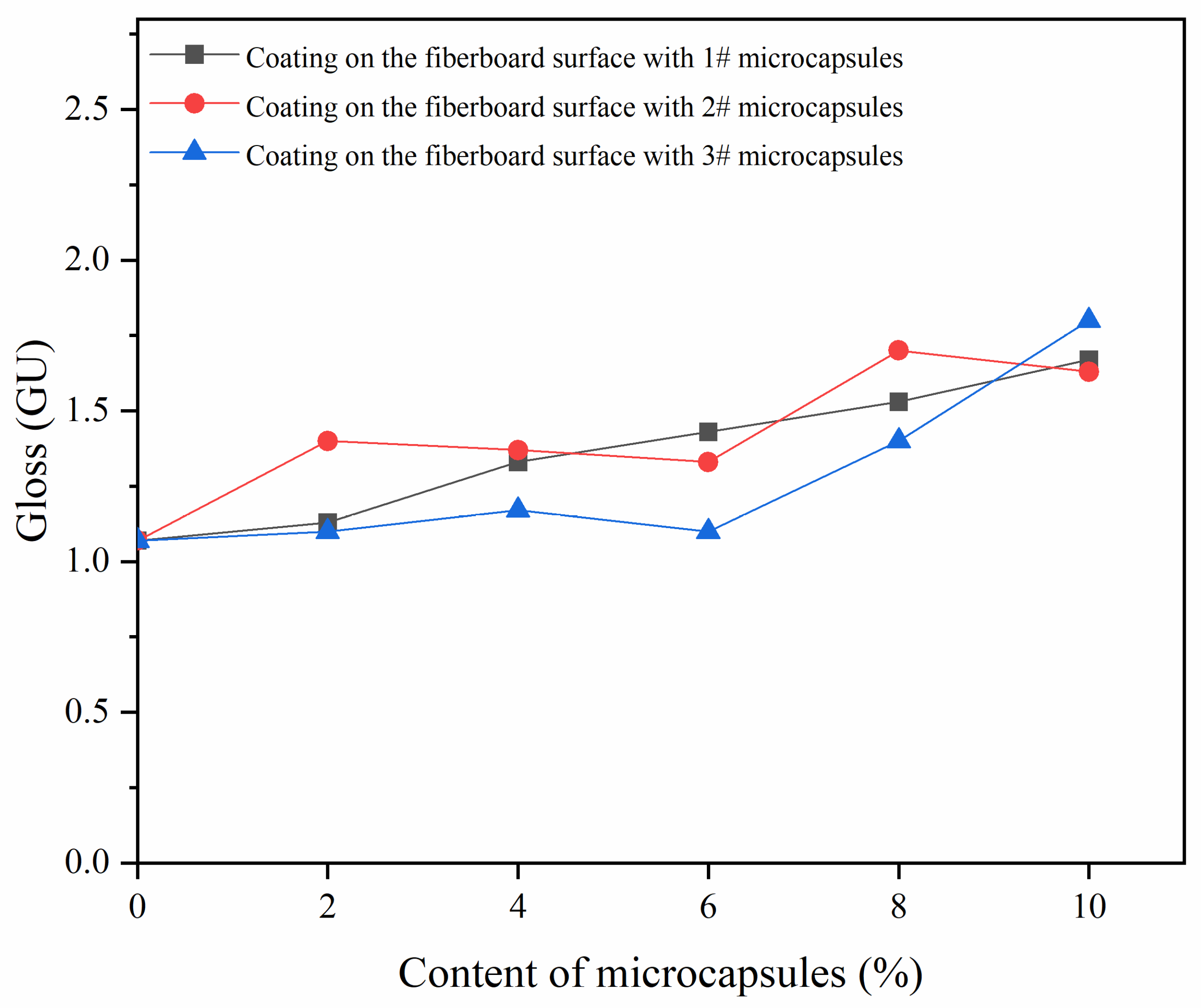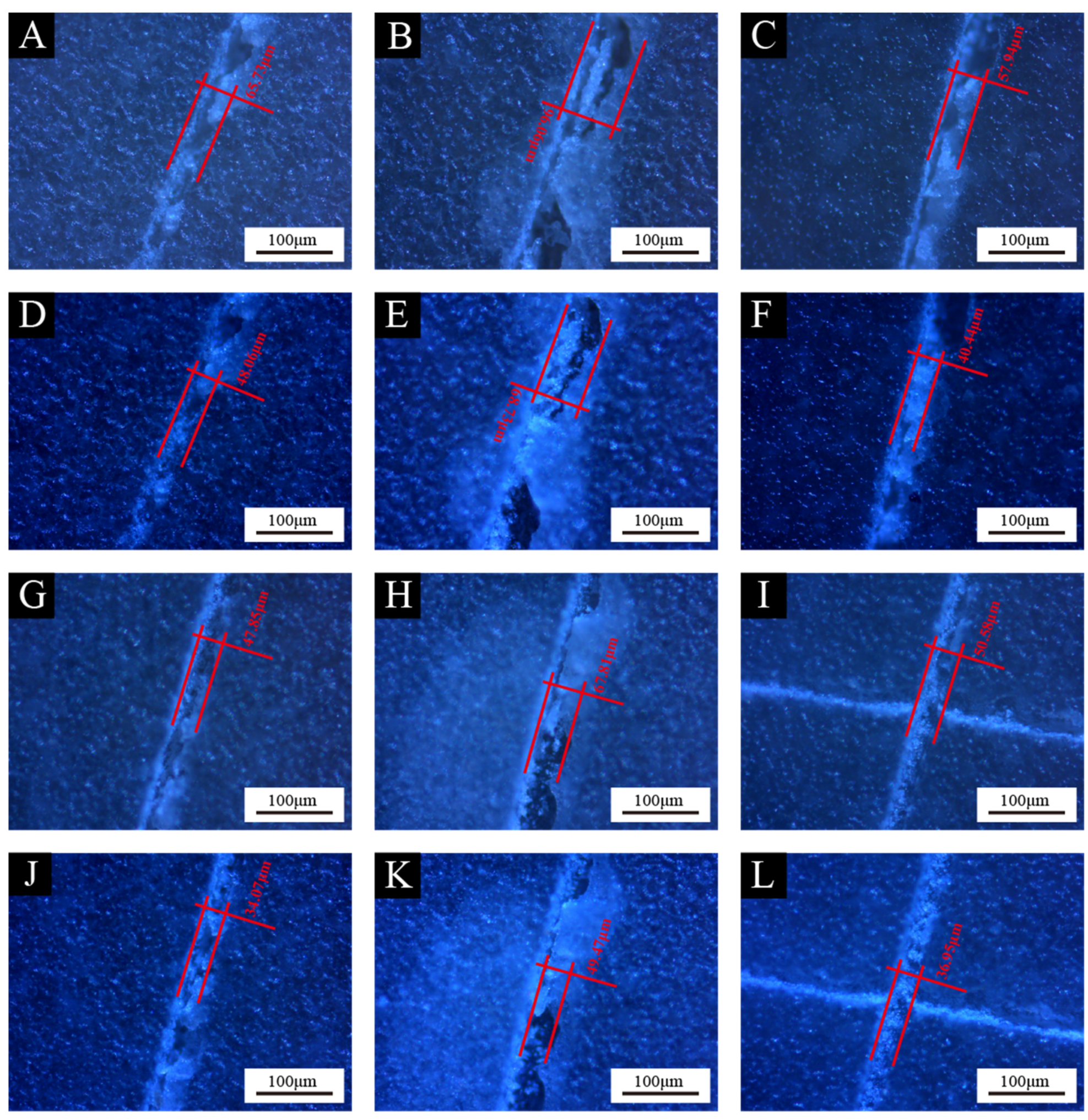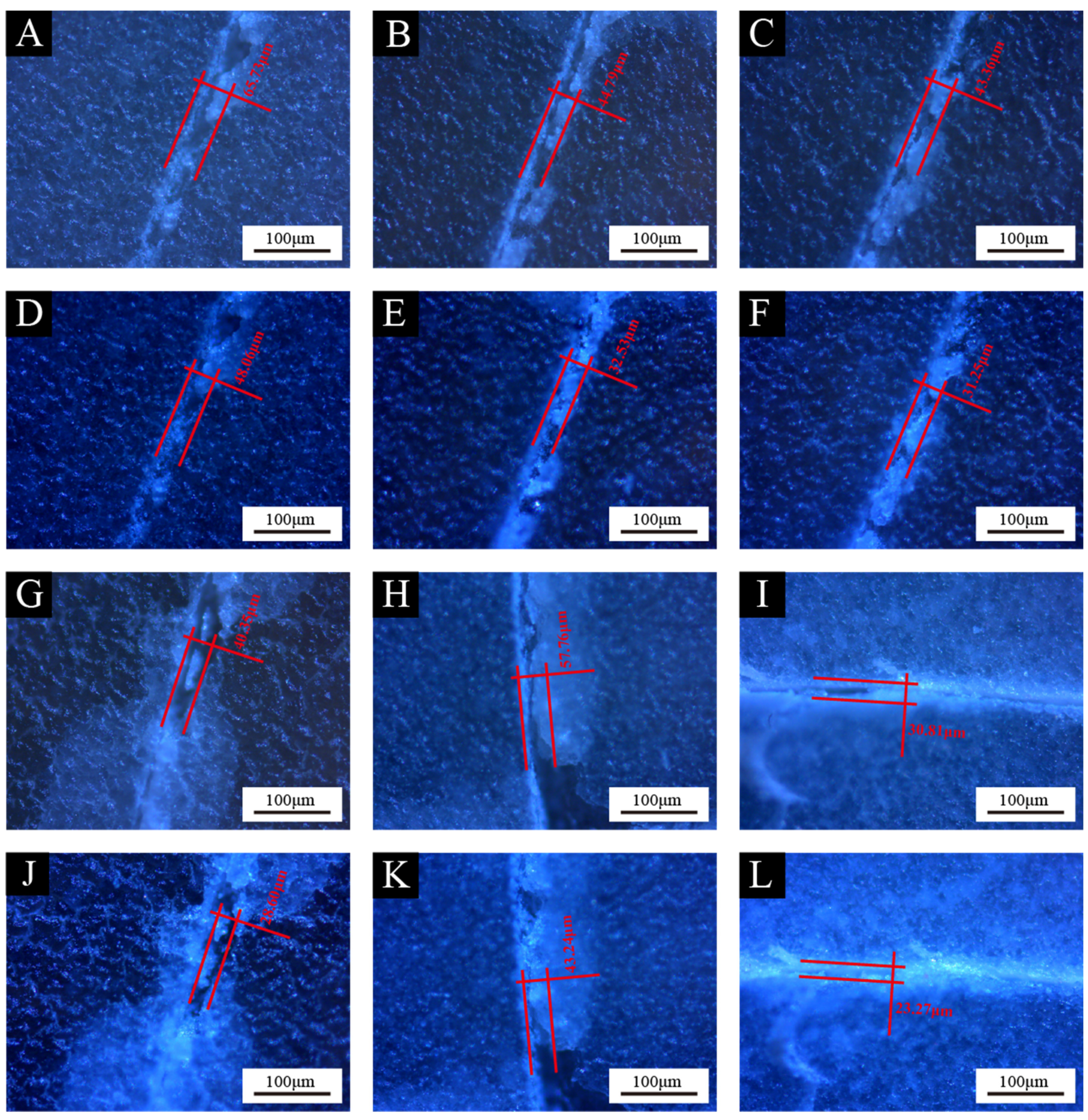Effects of Compound Use of Two UV Coating Microcapsules on the Physicochemical, Optical, Mechanical, and Self-Healing Performance of Coatings on Fiberboard Surfaces
Abstract
:1. Introduction
2. Materials and Methods
2.1. Materials
2.2. Preparation Method of Three UV Coating Microcapsules
2.3. Preparation Method of UV Coatings on the Fiberboard Surface
2.4. Tests
2.4.1. Microscopic Characterization
2.4.2. Chemical Composition Test
2.4.3. Optical Performance Test
2.4.4. Mechanical Performance Test
2.4.5. Self-Healing Performance Test
3. Results and Discussion
3.1. Macroscopic Analysis
3.2. Chemical Analysis
3.3. Optical Analysis
3.3.1. Analysis of Color Difference
3.3.2. Gloss and Reflectance Analysis
3.4. Mechanical Analysis
3.5. Self-Healing Performance Analysis
4. Conclusions
Author Contributions
Funding
Institutional Review Board Statement
Informed Consent Statement
Data Availability Statement
Conflicts of Interest
References
- Yang, D.R.; Zhu, J.G. Recycling and Value-added Design of Discarded Wooden Furniture. Bioresources 2021, 16, 6953–6963. [Google Scholar] [CrossRef]
- Wang, C.; Zhang, C.Y.; Zhu, Y. Reverse design and additive manufacturing of furniture protective foot covers. Bioresources 2024, 19, 4670–4678. [Google Scholar] [CrossRef]
- Zhu, J.G.; Niu, J.Y. Green Material Characteristics Applied to Office Desk Furniture. Bioresources 2022, 17, 2228–2242. [Google Scholar] [CrossRef]
- Zhu, H.L.; Luo, W.; Ciesielski, P.N.; Fang, Z.Q.; Zhu, J.Y.; Henriksson, G.; Himmel, M.E.; Hu, L.B. Wood-Derived Materials for Green Electronics, Biological Devices, and Energy Applications. Chem. Rev. 2016, 116, 9305–9374. [Google Scholar] [CrossRef] [PubMed]
- Zhang, Z.Y.; Zhu, J.G.; Qi, Q. Research on the Recyclable Design of Wooden Furniture Based on the Recyclability Evaluation. Sustainability 2023, 15, 16758. [Google Scholar] [CrossRef]
- Liu, Y.; Hu, W.G.; Kasal, A.; Erdil, Y.Z. The State of the Art of Biomechanics Applied in Ergonomic Furniture Design. Appl. Sci. 2023, 13, 12120. [Google Scholar] [CrossRef]
- Hu, W.G.; Luo, M.Y.; Liu, Y.Q.; Xu, W.; Konukcu, A.C. Experimental and numerical studies on the mechanical properties and behaviors of a novel wood dowel reinforced dovetail joint. Eng. Fail. Anal. 2023, 152, 107440. [Google Scholar] [CrossRef]
- Hu, W.G.; Luo, M.Y.; Hao, M.M.; Tang, B.; Wan, C. Study on the effects of selected factors on the diagonal tensile strength of oblique corner furniture joints constructed by wood dowel. Forests 2023, 14, 1149. [Google Scholar] [CrossRef]
- Wang, C.; Yu, J.H.; Jiang, M.H.; Li, J.Y. Effect of selective enhancement on the bending performance of fused deposition methods 3D-printed PLA models. Bioresources 2024, 19, 2660–2669. [Google Scholar] [CrossRef]
- Hu, W.G.; Liu, Y.; Li, S. Characterizing mode I fracture behaviors of wood using compact tension in selected system crack propagation. Forests 2021, 12, 1369. [Google Scholar] [CrossRef]
- Hu, W.G.; Fu, W.J.; Zhao, Y. Optimal design of the traditional Chinese wood furniture joint based on experimental and numerical method. Wood Res. 2024, 69, 50–59. [Google Scholar] [CrossRef]
- Hu, J.; Liu, Y.; Wang, J.X.; Xu, W. Study of selective modification effect of constructed structural color layers on European beech wood surfaces. Forests 2024, 15, 261. [Google Scholar] [CrossRef]
- Tao, M.X.; Liu, X.; Xu, W. Effect of the Vacuum Impregnation Process on Water Absorption and Nail-Holding Power of Silica Sol-Modified Chinese Fir. Forests 2024, 15, 270. [Google Scholar] [CrossRef]
- Wang, X.Y.; Liu, X.; Wu, S.S.; Xu, W. The influence of different impregnation factors on mechanical properties of silica sol-modified Populus tomentosa. Wood Fiber Sci. 2024, 56, 65–71. [Google Scholar]
- Miklecic, J.; Jirous-Rajkovic, V. Effectiveness of finishes in protecting wood from liquid water and water vapor. J. Build. Eng. 2021, 43, 102621. [Google Scholar] [CrossRef]
- Chang, Y.J.; Yan, X.X.; Wu, Z.H. Application and prospect of self-healing microcapsules in surface coating of wood. Colloid Interfac. Sci. 2023, 56, 100736. [Google Scholar] [CrossRef]
- Zigon, J.; Kovac, J.; Petric, M. The influence of mechanical, physical and chemical pre-treatment processes of wood surface on the relationships of wood with a waterborne opaque coating. Prog. Org. Coat. 2022, 162, 106574. [Google Scholar] [CrossRef]
- Czachor-Jadacka, D.; Pilch-Pitera, B. Progress in development of UV curable powder coatings. Prog. Org. Coat. 2021, 158, 106355. [Google Scholar] [CrossRef]
- Nowrouzi, Z.; Mohebby, B.; Petric, M.; Ebrahimi, M. Influence of nanoparticles and olive leaf extract in polyacrylate coating on the weathering performance of thermally modified wood. Eur. J. Wood Wood Prod. 2022, 80, 301–311. [Google Scholar] [CrossRef]
- Piao, X.X.; Guo, H.X.; Cao, Y.Z.; Wang, Z.; Jin, C.D. Exploration of multifunctional wood coating based on an interpenetrating network system of rosin-CO2-based polyurethane and mussel bionic rosin-based benzoxazine. J. Mater. Chem. B 2022, 36, 6939–6945. [Google Scholar] [CrossRef]
- Hu, W.G.; Wan, H. Comparative study on weathering durability properties of phenol formaldehyde resin modified sweetgum and southern pine specimens. Maderas-Cienc. Tecnol. 2022, 24, 17. [Google Scholar] [CrossRef]
- Hu, W.G.; Yu, R.Z. Mechanical and acoustic characteristics of four wood species subjected to bending load. Maderas-Cienc. Tecnol. 2023, 25, 39. [Google Scholar] [CrossRef]
- Hu, W.G.; Li, S.; Liu, Y. Vibrational characteristics of four wood species commonly used in wood products. Bioresources 2021, 16, 7101–7111. [Google Scholar] [CrossRef]
- Tao, Z.L.; Cui, J.C.; Qiu, H.X.; Yang, J.H.; Gao, S.L.; Li, J. Microcapsule/Silica dual-fillers for self-healing, self-reporting and corrosion protection properties of waterborne epoxy coatings. Prog. Org. Coat. 2021, 159, 106394. [Google Scholar] [CrossRef]
- Li, K.K.; Liu, Z.J.; Wang, C.J.; Fan, W.H.; Liu, F.T.; Li, H.Y.; Zhu, Y.J.; Wang, H.Y. Preparation of smart coatings with self-healing and anti-wear properties by embedding PU-fly ash absorbing linseed oil microcapsules. Prog. Org. Coat. 2020, 145, 105668. [Google Scholar] [CrossRef]
- da Cunha, A.B.M.; Leal, D.A.; Santos, L.R.L.; Riegel-Vidotti, I.C.; Marino, C.E.B. pH-sensitive microcapsules based on biopolymers for active corrosion protection of carbon steel at different pH. Surf. Coat. Tech. 2020, 402, 126338. [Google Scholar] [CrossRef]
- Wang, Q.H.; Thomas, J.; Soucek, M.D. Investigation of UV-curable alkyd coating properties. J. Coat. Technol. Res. 2023, 20, 545–557. [Google Scholar] [CrossRef]
- Guo, Z. Research advances in UV-curable self-healing coatings. RSC Adv. 2022, 12, 32429–32439. [Google Scholar] [CrossRef]
- Sow, C.; Riedl, B.; Blanchet, P. UV-waterborne polyurethane-acrylate nanocomposite coatings containing alumina and silica nanoparticles for wood: Mechanical, optical, and thermal properties assessment. J. Coat. Technol. Res. 2011, 8, 211–221. [Google Scholar] [CrossRef]
- Wu, Q.; Huang, X.; Liu, R.; Yang, X.Z.; Xiao, G.; Jiang, N.; Weitz, D.A.; Song, Y.J. Multichannel Multijunction Droplet Microfluidic Device to Synthesize Hydrogel Microcapsules with Different Core-Shell Structures and Adjustable Core Positions. Langmuir 2023, 40, 1950–1960. [Google Scholar] [CrossRef]
- Kim, A.L.; Musin, E.V.; Chebykin, Y.S.; Tikhonenko, S.A. Characterization of Polyallylamine/Polystyrene Sulfonate Polyelectrolyte Microcapsules Formed on Solid Cores: Morphology. Polymers 2024, 16, 1521. [Google Scholar] [CrossRef] [PubMed]
- Wang, R.; Kang, Y.J.; Lei, T.X.; Li, S.J.; Zhou, Z.Y.; Xiao, Y. Microcapsules composed of stearic acid core and polyethylene glycol-based shell as a microcapsule phase change material. Int. J. Energy Res. 2021, 45, 9677–9684. [Google Scholar] [CrossRef]
- Zhang, L.C.; Chen, Y.X.; Wu, K.Y.; Sun, G.Q.; Liu, R.; Luo, J. One-pot efficient synthesis of amino-functionalized polyurethane capsules via photopolymerization for self-healing anticorrosion coatings. Prog. Org. Coat. 2024, 189, 108348. [Google Scholar] [CrossRef]
- Zou, Y.M.; Xia, Y.X.; Yan, X.X. Effect of UV Top Coating Microcapsules on the Coating Properties of Fiberboard Surfaces. Polymers 2024, 16, 2098. [Google Scholar] [CrossRef]
- Xia, Y.X.; Yan, X.X. Preparation of UV Topcoat Microcapsules and Their Effect on the Properties of UV Topcoat Paint Film. Polymers 2024, 16, 1410. [Google Scholar] [CrossRef]
- Weng, M.Y.; Zhu, Y.T.; Mao, W.G.; Zhou, J.C.; Xu, W. Nano-Silica/Urea-Formaldehyde Resin-Modified Fast-Growing Lumber Performance Study. Forests 2023, 14, 1440. [Google Scholar] [CrossRef]
- Hu, J.; Liu, Y.; Xu, W. Influence of Cell Characteristics on the Construction of Structural Color Layers on Wood Surfaces. Forests 2024, 15, 676. [Google Scholar] [CrossRef]
- GB/T 11186.3-1989; Methods for Measuring the Colour of Coating Films. Part III: Calculation of Colour Differences. Standardization Administration of the People’s Republic of China: Beijing, China, 1990.
- GB/T 4893.6-2013; Test of Surface Coatings of Furniture—Part 6: Determination of Gloss Value. Standardization Administration of the People’s Republic of China: Beijing, China, 2013.
- Wang, C.; Zhou, Z.Y. Optical properties and lampshade design applications of PLA 3D printing materials. Bioresources 2023, 18, 1545–1553. [Google Scholar] [CrossRef]
- Wang, C.; Yu, J.H.; Jiang, M.H.; Li, J.Y. Effect of slicing parameters on the light transmittance of 3D-printed polyethylene terephthalate glycol products. Bioresources 2024, 19, 500–509. [Google Scholar] [CrossRef]
- GB/T 1732-2020; Test of Surface Coatings of Furniture—Part 9: Determination of Impact Resistance of Coating Films. Standardization Administration of the People’s Republic of China: Beijing, China, 2020.
- Hu, W.G.; Zhang, J.L. Effect of growth rings on acoustic emission characteristic signals of southern yellow pine wood cracked in mode I. Constr. Build. Mater. 2022, 329, 127092. [Google Scholar] [CrossRef]
- GB/T 6739-2022; Paints and Varnishes—Determination of Film Hardness by Pencil Test. Standardization Administration of the People’s Republic of China: Beijing, China, 2022.
- Hu, W.G.; Liu, Y.; Konukcu, A.C. Study on withdrawal load resistance of screw in wood-based materials: Experimental and numerical. Wood Mater. Sci. Eng. 2023, 18, 334–343. [Google Scholar] [CrossRef]
- GB/T 4893.4-2013; Test of Surface Coatings of Furniture—Part 4: Determination of Adhesion-Cross Cut. Standardization Administration of the People’s Republic of China: Beijing, China, 2013.
- Saman, N.M.; Ang, D.T.C.; Shahabudin, N.; Gan, S.N.; Basirun, W.J. UV-curable alkyd coating with self-healing ability. RSC Adv. 2022, 12, 32429–32439. [Google Scholar] [CrossRef]











| Materials | Molecular Mass (g/mol) | CAS | Producer |
|---|---|---|---|
| Melamine | 126.12 | 108-78-1 | Nanjing Houxin Biotechnology Co., Ltd., Nanjing, China |
| 37% formaldehyde | 30.03 | 50-00-0 | Nantong Yaoxin Chemical Co., Ltd., Nantong, China |
| Triethanolamine | 149.19 | 102-71-6 | Nanjing Houxin Biotechnology Co., Ltd., Nanjing, China |
| Span-20 | 346.459 | 133-39-2 | Nanjing Houxin Biotechnology Co., Ltd., Nanjing, China |
| Triton X-100 | 646.85 | 9002-93-1 | Shandong Yousuo Chemical Technology Co., Ltd., Linyi, China |
| Absolute ethanol | 46.07 | 64-17-5 | Guangzhou Kema Chemical Technology Co., Ltd., Guangzhou, China |
| UV top coating | - | - | Jiangsu Himonia Technology Co., Ltd., Zhenjiang, China |
| 1-hydroxycyclohexyl phenyl ketone | - | - | Jiangsu Himonia Technology Co., Ltd., Zhenjiang, China |
| UV primer | - | - | Jiangsu Himonia Technology Co., Ltd., Zhenjiang, China |
| 2-hydroxy-2-methylpropiophenone | - | - | Jiangsu Himonia Technology Co., Ltd., Zhenjiang, China |
| Citric acid monohydrate | 210.139 | 5949-29-1 | Jinan Xiaoshi Chemical Co., Ltd., Jinan, China |
| Test Instruments | Model | Manufacturer |
|---|---|---|
| Water bath | DF-101S | Henan Heming Instrument Equipment Co., Ltd., Zhengzhou, China |
| Scanning electron microscope (SEM) | Zeiss Sigma 300 | FEI Company, Hillsboro, OR, USA |
| Infrared spectrometer | VERTEX 80V | Germany BRUKER Co., Ltd., Karlsruhe, Germany |
| Color difference instrument | SEGT-J | Suzhou Weifu Photoelectric Technology Co., Ltd., Suzhou, China |
| Gloss meter | LS195 | Shenzhen Linshang Technology Co., Ltd., Shenzhen, China |
| Ultraviolet spectrophotometer | U-3900 | Shanghai Smeo Analytical Instrument Co., Ltd., Shanghai, China |
| Coating roughness tester | SJ-411 | Shanghai Taiming Optical Instrument Co., Ltd., Shanghai, China |
| Single-lamp curing machine | 620# | Huzhou Tongxu Machinery Equipment Co., Ltd., Huzhou, China |
| Sample (#) | Triton X-100 (g) | Span 20 (g) | Ethanol (mL) | UV primer (g) | UV Top Coating (g) | Formaldehyde (g) | Melamine (g) | Deionized Water (mL) |
|---|---|---|---|---|---|---|---|---|
| 1 | 0.08 | 0.22 | 78.90 | 4.40 | - | 10.81 | 4.80 | 24.00 |
| 2 | 0.08 | 0.22 | 78.90 | 4.40 | - | 9.83 | 4.36 | 21.82 |
| 3 | 0.08 | 0.22 | 78.90 | 4.40 | - | 9.01 | 4.00 | 20.00 |
| UV top coating microcapsule | 0.08 | 0.22 | 78.90 | - | 4.40 | 13.52 | 6.00 | 30.00 |
| Content of UV Primer Microcapsules (%) | Mass of UV Primer Microcapsules (g) | Mass of UV Primer (g) | Content of UV Top Coating Microcapsules (%) | Mass of UV Top Coating Microcapsules (g) | Mass of UV Top Coating (g) |
|---|---|---|---|---|---|
| 0 | 0 | 0.800 | 6.0 | 0.048 | 0.752 |
| 2.0 | 0.016 | 0.784 | 6.0 | 0.048 | 0.752 |
| 4.0 | 0.032 | 0.768 | 6.0 | 0.048 | 0.752 |
| 6.0 | 0.048 | 0.752 | 6.0 | 0.048 | 0.752 |
| 8.0 | 0.064 | 0.736 | 6.0 | 0.048 | 0.752 |
| 10.0 | 0.080 | 0.720 | 6.0 | 0.048 | 0.752 |
| Samples | Content of UV Primer Microcapsules (%) | L | a | b | ΔE |
|---|---|---|---|---|---|
| Samples with 1# microcapsules | 0 | 49.97 | 2.67 | 7.43 | - |
| 2.0 | 49.87 | 2.93 | 8.30 | 0.91 | |
| 4.0 | 46.90 | 4.53 | 7.43 | 3.59 | |
| 6.0 | 55.90 | 1.53 | 6.77 | 6.08 | |
| 8.0 | 57.33 | 1.63 | 6.33 | 7.52 | |
| 10.0 | 58.73 | 1.13 | 6.53 | 8.95 | |
| Samples with 2# microcapsules | 0 | 49.97 | 2.67 | 7.43 | - |
| 2.0 | 49.80 | 3.23 | 7.40 | 0.59 | |
| 4.0 | 53.03 | 1.87 | 7.10 | 3.19 | |
| 6.0 | 45.67 | 4.57 | 8.63 | 4.85 | |
| 8.0 | 57.67 | 1.33 | 6.83 | 7.84 | |
| 10.0 | 61.00 | 0.33 | 6.90 | 11.29 | |
| Samples with 3# microcapsules | 0 | 49.97 | 2.67 | 7.43 | - |
| 2.0 | 48.07 | 4.13 | 8.63 | 2.68 | |
| 4.0 | 55.50 | 2.10 | 6.90 | 5.59 | |
| 6.0 | 55.57 | 2.00 | 6.43 | 5.73 | |
| 8.0 | 43.73 | 5.83 | 9.83 | 7.39 | |
| 10.0 | 59.57 | 0.93 | 6.83 | 9.77 |
| Samples | Content of UV Primer Microcapsules (%) | Gloss (GU) | Reflectance (%) | ||
|---|---|---|---|---|---|
| 20° | 60° | 85° | |||
| Samples with 1# microcapsules | 0 | 0.20 | 1.07 | 3.60 | 18.93 |
| 2.0 | 0.20 | 1.13 | 3.70 | 21.57 | |
| 4.0 | 0.30 | 1.33 | 5.33 | 21.17 | |
| 6.0 | 0.50 | 1.43 | 5.43 | 29.97 | |
| 8.0 | 0.27 | 1.53 | 11.93 | 26.50 | |
| 10.0 | 0.37 | 1.67 | 13.37 | 29.20 | |
| Samples with 2# microcapsules | 0 | 0.20 | 1.07 | 3.60 | 18.93 |
| 2.0 | 0.27 | 1.40 | 6.33 | 20.38 | |
| 4.0 | 0.33 | 1.37 | 9.50 | 22.52 | |
| 6.0 | 0.30 | 1.33 | 8.20 | 24.92 | |
| 8.0 | 0.37 | 1.70 | 5.27 | 27.29 | |
| 10.0 | 0.47 | 1.63 | 3.87 | 32.83 | |
| Samples with 3# microcapsules | 0 | 0.20 | 1.07 | 3.60 | 18.93 |
| 2.0 | 0.20 | 1.10 | 4.63 | 18.94 | |
| 4.0 | 0.23 | 1.17 | 5.37 | 21.88 | |
| 6.0 | 0.33 | 1.10 | 3.30 | 27.46 | |
| 8.0 | 0.37 | 1.40 | 5.43 | 30.39 | |
| 10.0 | 0.40 | 1.80 | 12.07 | 34.74 | |
| Samples | Content of Microcapsules (%) | Adhesion (Grade) | Hardness | Impact Resistance (Grade) | Roughness (μm) |
|---|---|---|---|---|---|
| Samples with 1# microcapsules | 0 | 1 | 2H | 5 | 1.063 |
| 2.0 | 1 | 2H | 5 | 1.065 | |
| 4.0 | 2 | 2H | 5 | 1.085 | |
| 6.0 | 2 | 2H | 4 | 1.336 | |
| 8.0 | 2 | 3H | 3 | 1.468 | |
| 10.0 | 2 | 4H | 3 | 2.064 | |
| Samples with 2# microcapsules | 0 | 1 | 2H | 5 | 1.063 |
| 2.0 | 1 | 2H | 5 | 0.794 | |
| 4.0 | 2 | 2H | 5 | 0.810 | |
| 6.0 | 2 | 2H | 4 | 0.956 | |
| 8.0 | 2 | 2H | 4 | 1.293 | |
| 10.0 | 2 | 3H | 3 | 1.451 | |
| Samples with 3# microcapsules | 0 | 1 | 2H | 5 | 1.063 |
| 2.0 | 2 | 2H | 5 | 1.179 | |
| 4.0 | 2 | 2H | 5 | 1.463 | |
| 6.0 | 2 | 2H | 5 | 1.766 | |
| 8.0 | 2 | 3H | 4 | 2.139 | |
| 10.0 | 2 | 3H | 4 | 2.598 |
| Samples | Content of Microcapsules (%) | Crack Width after Scratch (μm) | Crack Width after 1 Week of Self-Healing (μm) | Self-Healing Rates (%) |
|---|---|---|---|---|
| Samples with 1# microcapsules | 0 | 65.73 | 48.06 | 26.89 |
| 2.0 | 96.06 | 68.73 | 28.45 | |
| 4.0 | 57.94 | 40.44 | 30.21 | |
| 6.0 | 47.85 | 34.07 | 28.79 | |
| 8.0 | 67.81 | 49.47 | 27.05 | |
| 10.0 | 50.58 | 36.95 | 26.95 | |
| Samples with 2# microcapsules | 0 | 65.73 | 48.06 | 26.89 |
| 2.0 | 56.63 | 40.86 | 27.84 | |
| 4.0 | 82.66 | 57.79 | 30.09 | |
| 6.0 | 76.71 | 54.53 | 28.92 | |
| 8.0 | 85.92 | 63.52 | 26.07 | |
| 10.0 | 58.19 | 43.24 | 25.69 | |
| Samples with 3# microcapsules | 0 | 65.73 | 48.06 | 26.89 |
| 2.0 | 44.79 | 32.53 | 27.38 | |
| 4.0 | 43.36 | 31.25 | 27.92 | |
| 6.0 | 40.35 | 28.60 | 29.12 | |
| 8.0 | 57.76 | 43.24 | 25.13 | |
| 10.0 | 30.81 | 23.27 | 24.46 |
Disclaimer/Publisher’s Note: The statements, opinions and data contained in all publications are solely those of the individual author(s) and contributor(s) and not of MDPI and/or the editor(s). MDPI and/or the editor(s) disclaim responsibility for any injury to people or property resulting from any ideas, methods, instructions or products referred to in the content. |
© 2024 by the authors. Licensee MDPI, Basel, Switzerland. This article is an open access article distributed under the terms and conditions of the Creative Commons Attribution (CC BY) license (https://creativecommons.org/licenses/by/4.0/).
Share and Cite
Zou, Y.; Xia, Y.; Yan, X. Effects of Compound Use of Two UV Coating Microcapsules on the Physicochemical, Optical, Mechanical, and Self-Healing Performance of Coatings on Fiberboard Surfaces. Coatings 2024, 14, 1012. https://doi.org/10.3390/coatings14081012
Zou Y, Xia Y, Yan X. Effects of Compound Use of Two UV Coating Microcapsules on the Physicochemical, Optical, Mechanical, and Self-Healing Performance of Coatings on Fiberboard Surfaces. Coatings. 2024; 14(8):1012. https://doi.org/10.3390/coatings14081012
Chicago/Turabian StyleZou, Yuming, Yongxin Xia, and Xiaoxing Yan. 2024. "Effects of Compound Use of Two UV Coating Microcapsules on the Physicochemical, Optical, Mechanical, and Self-Healing Performance of Coatings on Fiberboard Surfaces" Coatings 14, no. 8: 1012. https://doi.org/10.3390/coatings14081012
APA StyleZou, Y., Xia, Y., & Yan, X. (2024). Effects of Compound Use of Two UV Coating Microcapsules on the Physicochemical, Optical, Mechanical, and Self-Healing Performance of Coatings on Fiberboard Surfaces. Coatings, 14(8), 1012. https://doi.org/10.3390/coatings14081012





